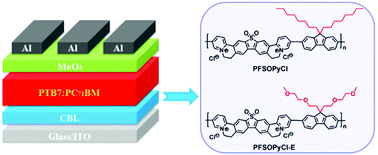Dibenzothiophene-S,S-dioxide-bispyridinium-fluorene-based polyelectrolytes for cathode buffer layers of polymer solar cells†
Abstract
Herein, a novel electron-deficient conjugated water/alcohol-soluble polyelectrolyte (WSPE) named PFSOPyCl-E, consisting of dibenzothiophene-S,S-dioxide, bispyridinium salts and fluorene with ethylene oxide side chains, was presented. Previously we have synthesized another WSPE (PFSOPyCl) composed of the same backbone as that of PFSOPyCl-E but with octyl side chains. PFSOPyCl and PFSOPyCl-E were applied as cathode buffer materials (CBMs) to inverted polymer solar cells (PSCs) of poly[4,8-bis(2-ethylhexyloxyl)benzo[1,2-b:4,5-b′]dithiophene-2,6-diyl-alt-ethylhexyl-3-fluorothithieno[3,4-b]thiophene-2-carboxylate-4,6-diyl] (PTB7):[6,6]-phenyl-C71 butyric acid methyl ester (PC71BM) systems, and simultaneous enhancements in open-circuit voltage (Voc), short-circuit current density (Jsc) and fill factor (FF) could be achieved when inserting these cathode buffer layers (CBLs). It was found that these CBLs could build directed dipoles at the indium tin oxide (ITO)/active layer interfaces, leading to the reductions in the ITO work function (WF) and improvements in Voc for the modified devices. The Jsc and FFs of PSCs were increased by several mechanisms. Firstly, the energy level alignments between the reduced ITO WFs (4.30–4.32 eV), deep LUMO energy levels (ELUMO) of these CBLs (4.04–4.10 eV) and ELUMO of PC71BM (∼3.90 eV) could generate good ohmic contacts, facilitating electron extractions and transportations. Secondly, these CBLs were able to n-dope PC71BM at the interfaces, inducing efficient electron-transporting pathways in the devices. Moreover, these polar polymeric CBLs could improve the compatibilities between ITO and the active layers, thus decreasing the interfacial resistances. It is worth noting that PFSOPyCl-E showed better cathode-modifying performance than PFSOPyCl, probably since PFSOPyCl-E with ethylene oxide side chains of high polarity and flexibility possessed better wettability with ITO and smoother films than PFSOPyCl. Hence, the devices modified by PFSOPyCl-E displayed lower contact resistances and higher FFs and Jsc than the PFSOPyCl-modified ones. Therefore, this class of electron-deficient conjugated WSPEs are promising CBMs for high-performance PSCs.



 Please wait while we load your content...
Please wait while we load your content...